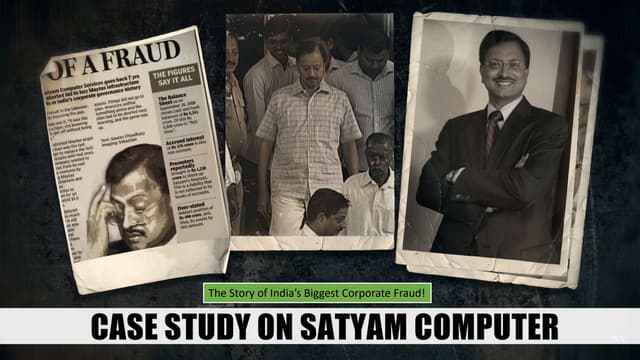The Satyam Scandal
A House of Cards Built on Lies
The Satyam Computer Services scandal, unearthed in 2009, remains one of the most shocking corporate frauds in Indian history. It exposed a web of deceit orchestrated by the company's founder, B. Ramalinga Raju, and exposed serious deficiencies in India's corporate governance system. Let's delve into the step-by-step breakdown of the accounting manipulation and its aftermath.
A Step-by-Step Look at the Accounting Shenanigans:
Like most of the scandals, the culprit here as well was the Real Estate greed! All that was done was done due to B. Raju's desire and hope for the real estate to flourish in Hyderabad region. Here's what he and his brother actually did, in a nutshell.
Step 1 - Create a Shell Company (Maytas Infra).
Step 2 - Issue fake invoices from Satyam Computers. Inflate revenue, profit, cash, create fictitious employees working on those invoices.
Step 3 - To support the inflated figures, a network of fake invoices, bank statements, and customer contracts were created. This painted a picture of a flourishing company when, in reality, it was teetering on the brink of collapse.
Step 4 - Hide liabilities by creating fictitious assets and keeping them off the official balance sheet. This further distorted the company's true financial health.
Step 5 - The stock price rises looking along with the inflated financial statements. B. Raju, his brother and their associates start offloading their shares in Satyam and buying properties under Maytas Infra. This was done in the hopes that the rising Real Estate market will give the profit they need to fulfill the gap in the financial position of Satyam Computers.
However, in 2008, the market collapsed! Property rates crumbled and B. Raju went in a fix!
Step 6 - Think of something else! B. Raju proposed and made Satyam Computers buy out Maytas Infra in cash(on papers, not actually). This was supposed to lower the cash position in Satyam Computers to what it originally is and will be an appropriate fix.
But, to his dismay, the shareholders weren't really happy with the acquisition. Hence, the acquisition was eventually shelved and now, B. Raju was out of options. A letter was written by B. Raju to the then Prime Minister Dr. Manmohan Singh of the malpractices going on in Satyam Computers and that's when everything bust out in the open
The Aftermath: A Rude Awakening
The Satyam scandal sent shockwaves through the Indian corporate world and beyond. Investors incurred significant losses, and India's reputation as a credible investment destination took a hit.
Ramifications for Raju: Raju and his associates were arrested and faced criminal charges. The company, after a period of turmoil, was eventually acquired by Tech Mahindra and rebranded.
Impact on Investors and Public Trust: The scandal eroded investor confidence in Indian companies and highlighted the need for stricter regulations and enforcement mechanisms.
Scrutiny on Auditors: PwC faced severe criticism for their failure to detect the fraud. This led to increased scrutiny on the role and responsibilities of auditors in ensuring financial reporting accuracy. They were eventually, in 2018, banned by SEBI from auditing listed corporations for two years.
Preventive Measures: A Course Correction
Following the Satyam scandal, the Indian government and regulatory bodies took several steps to prevent similar incidents from happening again:
Strengthened Corporate Governance: The Companies Act, 2013, was introduced, mandating stricter governance practices and enhanced disclosures by companies. This included provisions for independent directors, whistle-blower protection, and stronger audit committees.
Increased Scrutiny on Auditors: Regulatory bodies like the Securities and Exchange Board of India (SEBI) implemented stricter regulations for auditors, including mandatory rotation of audit firms and enhanced penalties for negligence.
Focus on Internal Controls: The importance of robust internal controls within companies was emphasized to prevent fraudulent activities.
The Road Ahead: Lessons Learned
The Satyam scandal is a stark reminder of the importance of ethical behavior and transparency in corporate practices. It also highlights the need for robust corporate governance and a culture of accountability. While India has taken steps to address these issues, continuous vigilance and improvement are crucial to ensure a healthy and trustworthy business environment.
The scandal serves as a cautionary tale, not just for India but for the global corporate world. It underscores the importance of:
Independent verification: Effective audits and due diligence processes are critical in detecting potential fraud.
Ethical leadership: Strong corporate governance and ethical leadership are essential to create a culture of transparency and accountability.
Regulatory oversight: Robust regulatory frameworks and efficient enforcement mechanisms are crucial in safeguarding investors and maintaining market integrity.
By learning from the mistakes of the past, we can build a more secure and trustworthy financial ecosystem for the future.


